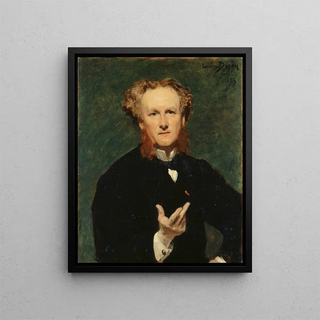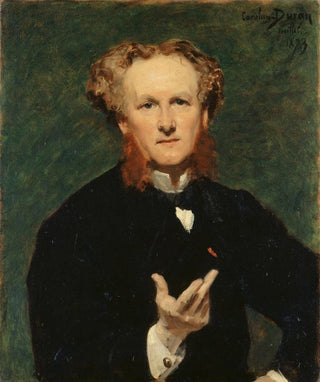Art print Portrait of Étienne Haro - Carolus-Duran | Art print


View from behind

Frame (optional)
Portrait of Étienne Haro - Carolus-Duran – Captivating Introduction
The "Portrait of Étienne Haro" by Carolus-Duran is an iconic work that transcends the simple frame of painting to become a true testament to 19th-century society. This painting, which depicts with remarkable finesse the face of a man of letters, invites the viewer to immerse themselves in a universe where art and everyday life intersect. The delicate light emanating from the canvas, as well as the intensity of the expressions, capture the very essence of the subject, making this work unforgettable. Through this art print, the spirit of the era and the artist's talent combine to offer an immersion into a period rich in creativity and innovation.
Style and uniqueness of the work
Carolus-Duran's style is distinguished by its striking realism, a characteristic that manifests brilliantly in the "Portrait of Étienne Haro." The brushwork technique, both supple and precise, allows textures and nuances of the skin to be rendered with impressive authenticity. The interplay of light and shadow, skillfully orchestrated, brings the face of the subject to life, creating a depth that seems almost tangible. The composition, meanwhile, is carefully thought out, with a simple background that highlights the central figure. This stylistic choice emphasizes the dignity and importance of the depicted man, while also offering a reflection on the role of the individual in society. In sum, this work stands out for its technical mastery and intimate approach, inviting the viewer to contemplate not only the portrait but also the story behind it.
The artist and his influence
Carolus-Duran, whose real name is Charles Émile Auguste Durand, was a French painter whose influence marked the artistic scene of his time. Trained at the École des beaux-arts in Paris, he established himself as a master of portraiture, attracting the attention of the elites of his era. His innovative approach, blending realism and impressionism, paved the way for many artists who followed in his footsteps. By depicting his models with such humanity, Duran succeeded in establishing a strong emotional connection between the work and the viewer.

Matte finish

View from behind

Frame (optional)
Portrait of Étienne Haro - Carolus-Duran – Captivating Introduction
The "Portrait of Étienne Haro" by Carolus-Duran is an iconic work that transcends the simple frame of painting to become a true testament to 19th-century society. This painting, which depicts with remarkable finesse the face of a man of letters, invites the viewer to immerse themselves in a universe where art and everyday life intersect. The delicate light emanating from the canvas, as well as the intensity of the expressions, capture the very essence of the subject, making this work unforgettable. Through this art print, the spirit of the era and the artist's talent combine to offer an immersion into a period rich in creativity and innovation.
Style and uniqueness of the work
Carolus-Duran's style is distinguished by its striking realism, a characteristic that manifests brilliantly in the "Portrait of Étienne Haro." The brushwork technique, both supple and precise, allows textures and nuances of the skin to be rendered with impressive authenticity. The interplay of light and shadow, skillfully orchestrated, brings the face of the subject to life, creating a depth that seems almost tangible. The composition, meanwhile, is carefully thought out, with a simple background that highlights the central figure. This stylistic choice emphasizes the dignity and importance of the depicted man, while also offering a reflection on the role of the individual in society. In sum, this work stands out for its technical mastery and intimate approach, inviting the viewer to contemplate not only the portrait but also the story behind it.
The artist and his influence
Carolus-Duran, whose real name is Charles Émile Auguste Durand, was a French painter whose influence marked the artistic scene of his time. Trained at the École des beaux-arts in Paris, he established himself as a master of portraiture, attracting the attention of the elites of his era. His innovative approach, blending realism and impressionism, paved the way for many artists who followed in his footsteps. By depicting his models with such humanity, Duran succeeded in establishing a strong emotional connection between the work and the viewer.
12,34 €






